Report: Attachment Theory and Infant Development (COU103A)
VerifiedAdded on 2023/06/11
|10
|2639
|245
Report
AI Summary
This report examines attachment theory and its role in human development across the lifespan. It begins by defining lifespan development and attachment theory, followed by a review of early findings and work on attachment theory, including the contributions of John Bowlby and Mary Ainsworth. The report then delves into adult attachment theories, explaining how childhood attachment experiences shape adult relationships and behaviors. The core of the report addresses the statement that "Secure attachment was once viewed as important for infant development. More recently, it has been deemed the most important ingredient for successful relationship formation, strong self-identity & confidence to function and achieve in our lifetime," providing an analysis of the evidence and arguments for and against the statement. The report concludes with a summary of the key findings and implications of attachment theory for understanding human development and well-being. The report also includes references to relevant literature, supporting the analysis with research and scholarly sources. Finally, the report provides a critical evaluation of the current perspectives on attachment theory and its practical applications.
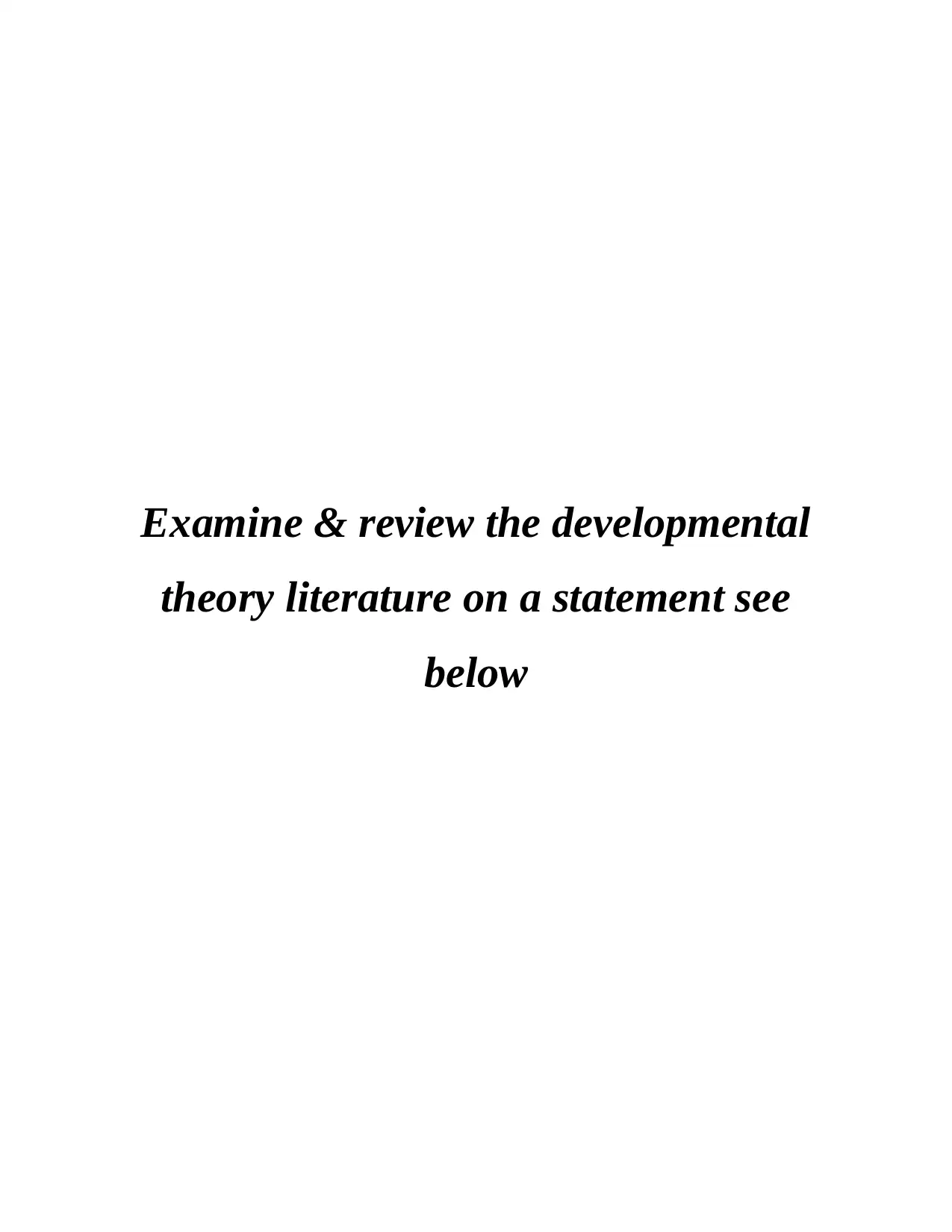
Examine & review the developmental
theory literature on a statement see
below
theory literature on a statement see
below
Paraphrase This Document
Need a fresh take? Get an instant paraphrase of this document with our AI Paraphraser

Table of Contents
1. Explain what life span development study is...........................................................................3
2. Explain what attachment theory says.......................................................................................3
3. Explain the early findings/work on attachment theory............................................................4
4. Explain the adult attachment theories (quote from literature that you reviewed)
& explain how adult attachment is impacted from childhood attachment......................................5
Bowlby's Theory of Attachment..................................................................................................5
5. Based on the above, explain as to why you agree or disagree on the below statement...........6
6. “Secure attachment was once viewed as important for infant development............................7
7. Provide a conclusion................................................................................................................7
References........................................................................................................................................9
1. Explain what life span development study is...........................................................................3
2. Explain what attachment theory says.......................................................................................3
3. Explain the early findings/work on attachment theory............................................................4
4. Explain the adult attachment theories (quote from literature that you reviewed)
& explain how adult attachment is impacted from childhood attachment......................................5
Bowlby's Theory of Attachment..................................................................................................5
5. Based on the above, explain as to why you agree or disagree on the below statement...........6
6. “Secure attachment was once viewed as important for infant development............................7
7. Provide a conclusion................................................................................................................7
References........................................................................................................................................9
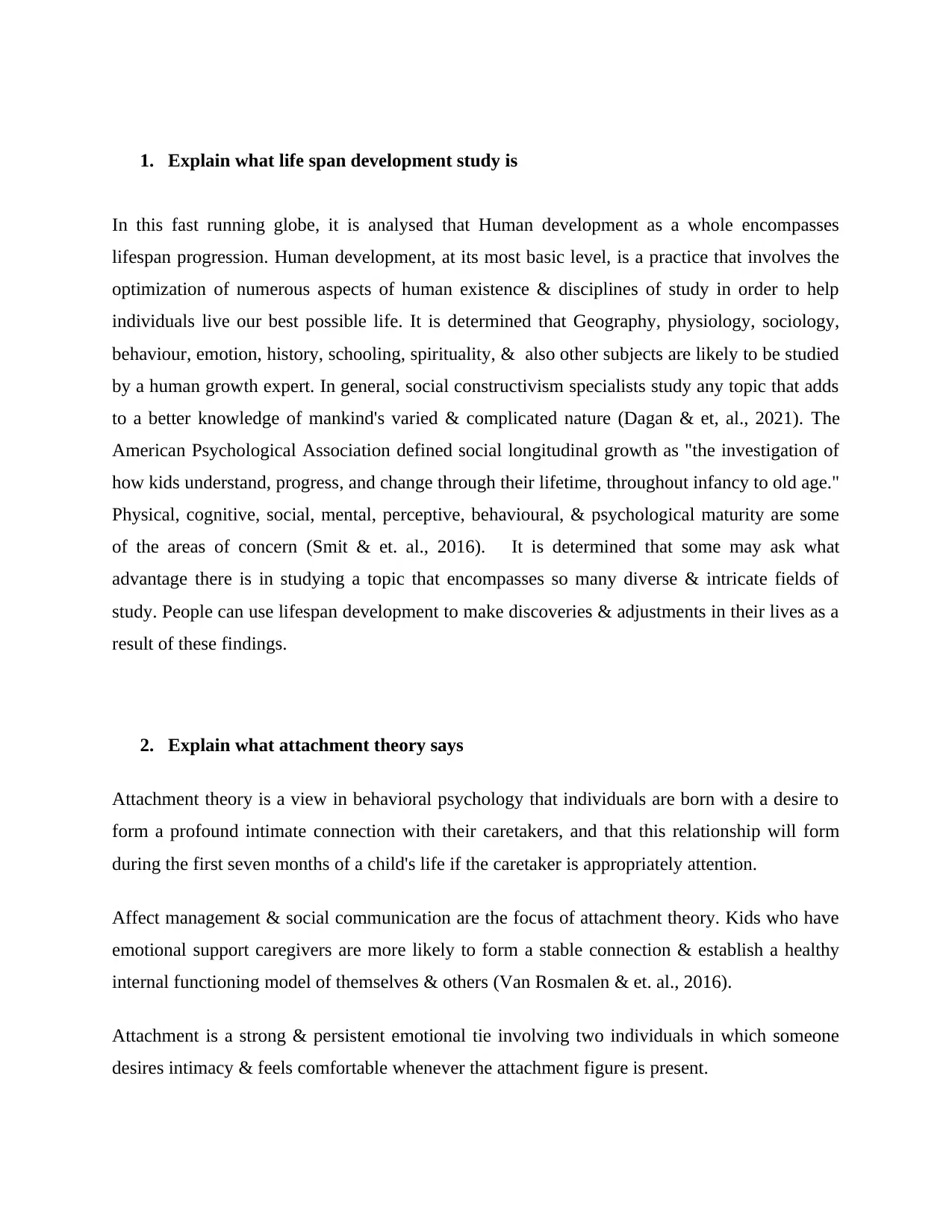
1. Explain what life span development study is
In this fast running globe, it is analysed that Human development as a whole encompasses
lifespan progression. Human development, at its most basic level, is a practice that involves the
optimization of numerous aspects of human existence & disciplines of study in order to help
individuals live our best possible life. It is determined that Geography, physiology, sociology,
behaviour, emotion, history, schooling, spirituality, & also other subjects are likely to be studied
by a human growth expert. In general, social constructivism specialists study any topic that adds
to a better knowledge of mankind's varied & complicated nature (Dagan & et, al., 2021). The
American Psychological Association defined social longitudinal growth as "the investigation of
how kids understand, progress, and change through their lifetime, throughout infancy to old age."
Physical, cognitive, social, mental, perceptive, behavioural, & psychological maturity are some
of the areas of concern (Smit & et. al., 2016). It is determined that some may ask what
advantage there is in studying a topic that encompasses so many diverse & intricate fields of
study. People can use lifespan development to make discoveries & adjustments in their lives as a
result of these findings.
2. Explain what attachment theory says
Attachment theory is a view in behavioral psychology that individuals are born with a desire to
form a profound intimate connection with their caretakers, and that this relationship will form
during the first seven months of a child's life if the caretaker is appropriately attention.
Affect management & social communication are the focus of attachment theory. Kids who have
emotional support caregivers are more likely to form a stable connection & establish a healthy
internal functioning model of themselves & others (Van Rosmalen & et. al., 2016).
Attachment is a strong & persistent emotional tie involving two individuals in which someone
desires intimacy & feels comfortable whenever the attachment figure is present.
In this fast running globe, it is analysed that Human development as a whole encompasses
lifespan progression. Human development, at its most basic level, is a practice that involves the
optimization of numerous aspects of human existence & disciplines of study in order to help
individuals live our best possible life. It is determined that Geography, physiology, sociology,
behaviour, emotion, history, schooling, spirituality, & also other subjects are likely to be studied
by a human growth expert. In general, social constructivism specialists study any topic that adds
to a better knowledge of mankind's varied & complicated nature (Dagan & et, al., 2021). The
American Psychological Association defined social longitudinal growth as "the investigation of
how kids understand, progress, and change through their lifetime, throughout infancy to old age."
Physical, cognitive, social, mental, perceptive, behavioural, & psychological maturity are some
of the areas of concern (Smit & et. al., 2016). It is determined that some may ask what
advantage there is in studying a topic that encompasses so many diverse & intricate fields of
study. People can use lifespan development to make discoveries & adjustments in their lives as a
result of these findings.
2. Explain what attachment theory says
Attachment theory is a view in behavioral psychology that individuals are born with a desire to
form a profound intimate connection with their caretakers, and that this relationship will form
during the first seven months of a child's life if the caretaker is appropriately attention.
Affect management & social communication are the focus of attachment theory. Kids who have
emotional support caregivers are more likely to form a stable connection & establish a healthy
internal functioning model of themselves & others (Van Rosmalen & et. al., 2016).
Attachment is a strong & persistent emotional tie involving two individuals in which someone
desires intimacy & feels comfortable whenever the attachment figure is present.
⊘ This is a preview!⊘
Do you want full access?
Subscribe today to unlock all pages.

Trusted by 1+ million students worldwide

• Reacting thoughtfully & properly to the kid's needs is an example of adult attachment styles
toward the child. • Attachment theory describes how the caregiver bond develops & shapes
change & growth, & it appears to be universal across cultures.
• Some who answered correctly to the child's cues seem to be more likely to build attachments
than those with whom they spent too much time. This is referred to as sensitive response by
Schaffer & Emerson (Granqvist, 2021).
• Practical steps in children are associated with attachments, including such desiring near to the
attachment figure when unhappy or frightened (Bowlby, 1969).
3. Explain the early findings/work on attachment theory
John Bowlby, a psychotherapist who researched the effects of detachment among infants and
their caregivers, is the first one to describe the behavioral model of psychological, according to
research (Fraley, 2010). Bowlby claimed that neonates' extreme behaviours, such as sobbing,
screaming, and grasping, were evolutionary techniques for avoiding separation from parenting or
reconciling with a located far away parent, according to the analysis. Natural selection, according
to Bowlby, had enhanced these tendencies, enhancing the child's odds of survival.
These human characteristics are natural responses to the prospect of losing important survival
advantages with being cared for and heard by the caregiver (s). Although neonates that engaged
in these acts were so much more likely to survive, the tendencies were automatically picked and
passed on to future generations (Fearon & Roisman, 2017).
Secure attachment – These babies were disturbed when apart from their caregivers,
although when their reappeared, they sought comfort and were quickly tried to comfort.
toward the child. • Attachment theory describes how the caregiver bond develops & shapes
change & growth, & it appears to be universal across cultures.
• Some who answered correctly to the child's cues seem to be more likely to build attachments
than those with whom they spent too much time. This is referred to as sensitive response by
Schaffer & Emerson (Granqvist, 2021).
• Practical steps in children are associated with attachments, including such desiring near to the
attachment figure when unhappy or frightened (Bowlby, 1969).
3. Explain the early findings/work on attachment theory
John Bowlby, a psychotherapist who researched the effects of detachment among infants and
their caregivers, is the first one to describe the behavioral model of psychological, according to
research (Fraley, 2010). Bowlby claimed that neonates' extreme behaviours, such as sobbing,
screaming, and grasping, were evolutionary techniques for avoiding separation from parenting or
reconciling with a located far away parent, according to the analysis. Natural selection, according
to Bowlby, had enhanced these tendencies, enhancing the child's odds of survival.
These human characteristics are natural responses to the prospect of losing important survival
advantages with being cared for and heard by the caregiver (s). Although neonates that engaged
in these acts were so much more likely to survive, the tendencies were automatically picked and
passed on to future generations (Fearon & Roisman, 2017).
Secure attachment – These babies were disturbed when apart from their caregivers,
although when their reappeared, they sought comfort and were quickly tried to comfort.
Paraphrase This Document
Need a fresh take? Get an instant paraphrase of this document with our AI Paraphraser
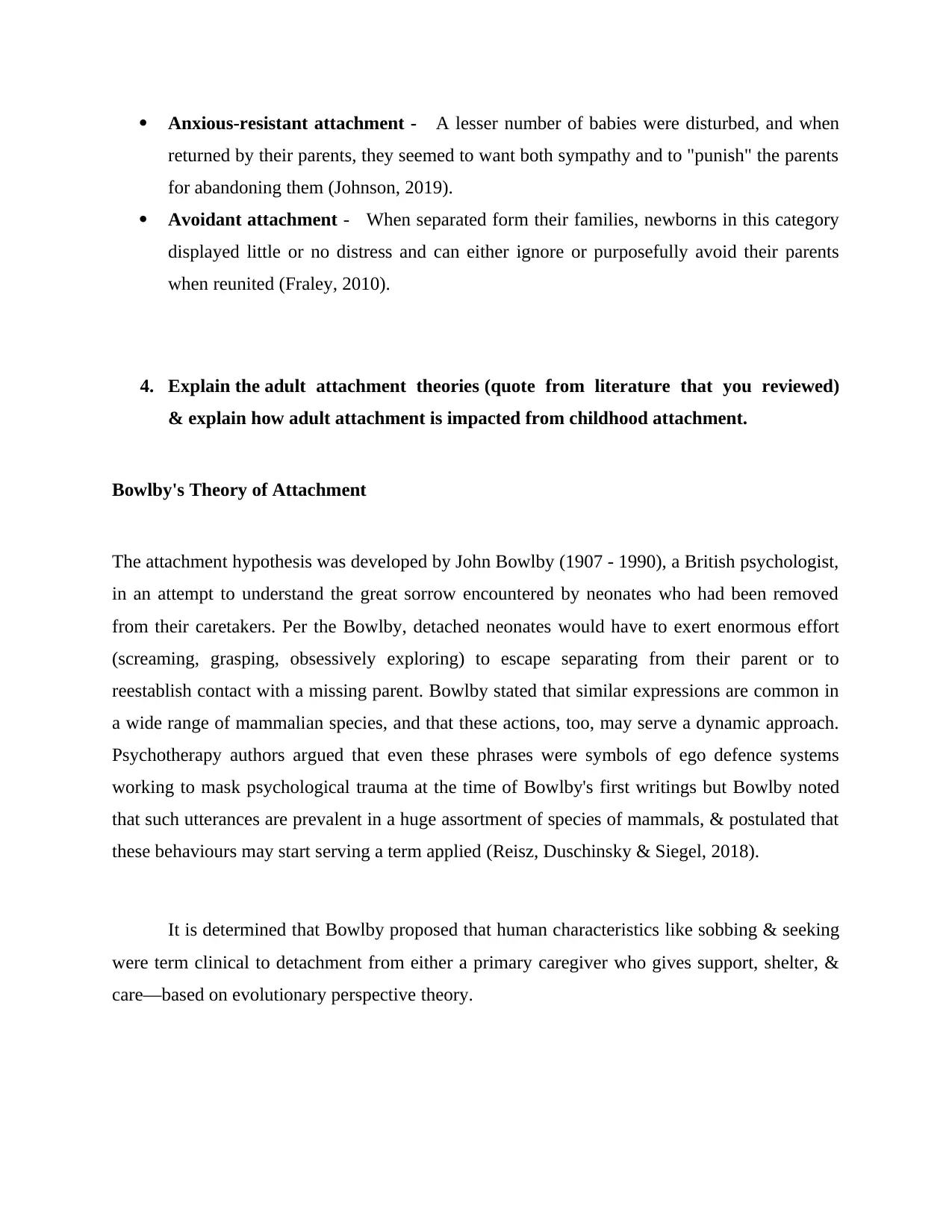
Anxious-resistant attachment - A lesser number of babies were disturbed, and when
returned by their parents, they seemed to want both sympathy and to "punish" the parents
for abandoning them (Johnson, 2019).
Avoidant attachment - When separated form their families, newborns in this category
displayed little or no distress and can either ignore or purposefully avoid their parents
when reunited (Fraley, 2010).
4. Explain the adult attachment theories (quote from literature that you reviewed)
& explain how adult attachment is impacted from childhood attachment.
Bowlby's Theory of Attachment
The attachment hypothesis was developed by John Bowlby (1907 - 1990), a British psychologist,
in an attempt to understand the great sorrow encountered by neonates who had been removed
from their caretakers. Per the Bowlby, detached neonates would have to exert enormous effort
(screaming, grasping, obsessively exploring) to escape separating from their parent or to
reestablish contact with a missing parent. Bowlby stated that similar expressions are common in
a wide range of mammalian species, and that these actions, too, may serve a dynamic approach.
Psychotherapy authors argued that even these phrases were symbols of ego defence systems
working to mask psychological trauma at the time of Bowlby's first writings but Bowlby noted
that such utterances are prevalent in a huge assortment of species of mammals, & postulated that
these behaviours may start serving a term applied (Reisz, Duschinsky & Siegel, 2018).
It is determined that Bowlby proposed that human characteristics like sobbing & seeking
were term clinical to detachment from either a primary caregiver who gives support, shelter, &
care—based on evolutionary perspective theory.
returned by their parents, they seemed to want both sympathy and to "punish" the parents
for abandoning them (Johnson, 2019).
Avoidant attachment - When separated form their families, newborns in this category
displayed little or no distress and can either ignore or purposefully avoid their parents
when reunited (Fraley, 2010).
4. Explain the adult attachment theories (quote from literature that you reviewed)
& explain how adult attachment is impacted from childhood attachment.
Bowlby's Theory of Attachment
The attachment hypothesis was developed by John Bowlby (1907 - 1990), a British psychologist,
in an attempt to understand the great sorrow encountered by neonates who had been removed
from their caretakers. Per the Bowlby, detached neonates would have to exert enormous effort
(screaming, grasping, obsessively exploring) to escape separating from their parent or to
reestablish contact with a missing parent. Bowlby stated that similar expressions are common in
a wide range of mammalian species, and that these actions, too, may serve a dynamic approach.
Psychotherapy authors argued that even these phrases were symbols of ego defence systems
working to mask psychological trauma at the time of Bowlby's first writings but Bowlby noted
that such utterances are prevalent in a huge assortment of species of mammals, & postulated that
these behaviours may start serving a term applied (Reisz, Duschinsky & Siegel, 2018).
It is determined that Bowlby proposed that human characteristics like sobbing & seeking
were term clinical to detachment from either a primary caregiver who gives support, shelter, &
care—based on evolutionary perspective theory.
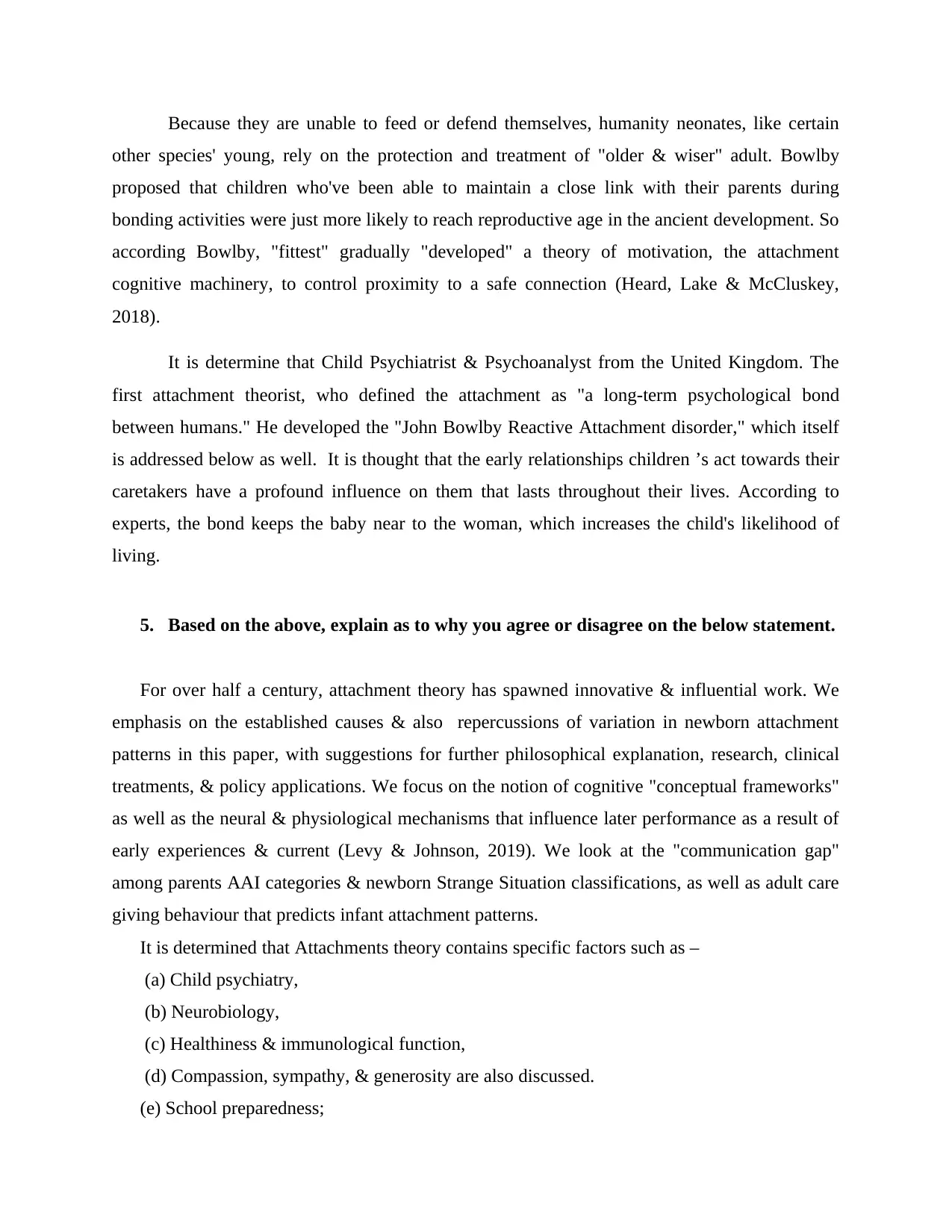
Because they are unable to feed or defend themselves, humanity neonates, like certain
other species' young, rely on the protection and treatment of "older & wiser" adult. Bowlby
proposed that children who've been able to maintain a close link with their parents during
bonding activities were just more likely to reach reproductive age in the ancient development. So
according Bowlby, "fittest" gradually "developed" a theory of motivation, the attachment
cognitive machinery, to control proximity to a safe connection (Heard, Lake & McCluskey,
2018).
It is determine that Child Psychiatrist & Psychoanalyst from the United Kingdom. The
first attachment theorist, who defined the attachment as "a long-term psychological bond
between humans." He developed the "John Bowlby Reactive Attachment disorder," which itself
is addressed below as well. It is thought that the early relationships children ’s act towards their
caretakers have a profound influence on them that lasts throughout their lives. According to
experts, the bond keeps the baby near to the woman, which increases the child's likelihood of
living.
5. Based on the above, explain as to why you agree or disagree on the below statement.
For over half a century, attachment theory has spawned innovative & influential work. We
emphasis on the established causes & also repercussions of variation in newborn attachment
patterns in this paper, with suggestions for further philosophical explanation, research, clinical
treatments, & policy applications. We focus on the notion of cognitive "conceptual frameworks"
as well as the neural & physiological mechanisms that influence later performance as a result of
early experiences & current (Levy & Johnson, 2019). We look at the "communication gap"
among parents AAI categories & newborn Strange Situation classifications, as well as adult care
giving behaviour that predicts infant attachment patterns.
It is determined that Attachments theory contains specific factors such as –
(a) Child psychiatry,
(b) Neurobiology,
(c) Healthiness & immunological function,
(d) Compassion, sympathy, & generosity are also discussed.
(e) School preparedness;
other species' young, rely on the protection and treatment of "older & wiser" adult. Bowlby
proposed that children who've been able to maintain a close link with their parents during
bonding activities were just more likely to reach reproductive age in the ancient development. So
according Bowlby, "fittest" gradually "developed" a theory of motivation, the attachment
cognitive machinery, to control proximity to a safe connection (Heard, Lake & McCluskey,
2018).
It is determine that Child Psychiatrist & Psychoanalyst from the United Kingdom. The
first attachment theorist, who defined the attachment as "a long-term psychological bond
between humans." He developed the "John Bowlby Reactive Attachment disorder," which itself
is addressed below as well. It is thought that the early relationships children ’s act towards their
caretakers have a profound influence on them that lasts throughout their lives. According to
experts, the bond keeps the baby near to the woman, which increases the child's likelihood of
living.
5. Based on the above, explain as to why you agree or disagree on the below statement.
For over half a century, attachment theory has spawned innovative & influential work. We
emphasis on the established causes & also repercussions of variation in newborn attachment
patterns in this paper, with suggestions for further philosophical explanation, research, clinical
treatments, & policy applications. We focus on the notion of cognitive "conceptual frameworks"
as well as the neural & physiological mechanisms that influence later performance as a result of
early experiences & current (Levy & Johnson, 2019). We look at the "communication gap"
among parents AAI categories & newborn Strange Situation classifications, as well as adult care
giving behaviour that predicts infant attachment patterns.
It is determined that Attachments theory contains specific factors such as –
(a) Child psychiatry,
(b) Neurobiology,
(c) Healthiness & immunological function,
(d) Compassion, sympathy, & generosity are also discussed.
(e) School preparedness;
⊘ This is a preview!⊘
Do you want full access?
Subscribe today to unlock all pages.

Trusted by 1+ million students worldwide
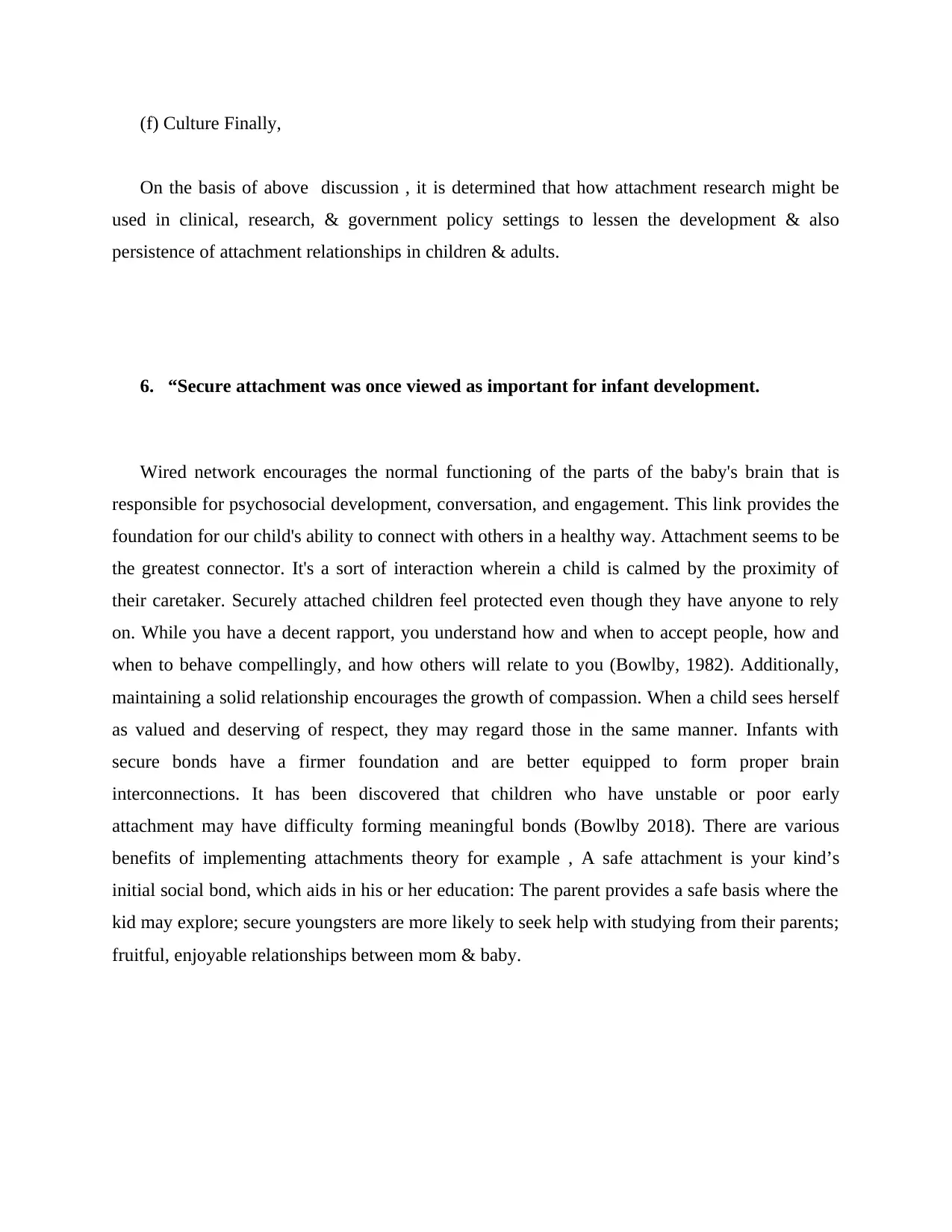
(f) Culture Finally,
On the basis of above discussion , it is determined that how attachment research might be
used in clinical, research, & government policy settings to lessen the development & also
persistence of attachment relationships in children & adults.
6. “Secure attachment was once viewed as important for infant development.
Wired network encourages the normal functioning of the parts of the baby's brain that is
responsible for psychosocial development, conversation, and engagement. This link provides the
foundation for our child's ability to connect with others in a healthy way. Attachment seems to be
the greatest connector. It's a sort of interaction wherein a child is calmed by the proximity of
their caretaker. Securely attached children feel protected even though they have anyone to rely
on. While you have a decent rapport, you understand how and when to accept people, how and
when to behave compellingly, and how others will relate to you (Bowlby, 1982). Additionally,
maintaining a solid relationship encourages the growth of compassion. When a child sees herself
as valued and deserving of respect, they may regard those in the same manner. Infants with
secure bonds have a firmer foundation and are better equipped to form proper brain
interconnections. It has been discovered that children who have unstable or poor early
attachment may have difficulty forming meaningful bonds (Bowlby 2018). There are various
benefits of implementing attachments theory for example , A safe attachment is your kind’s
initial social bond, which aids in his or her education: The parent provides a safe basis where the
kid may explore; secure youngsters are more likely to seek help with studying from their parents;
fruitful, enjoyable relationships between mom & baby.
On the basis of above discussion , it is determined that how attachment research might be
used in clinical, research, & government policy settings to lessen the development & also
persistence of attachment relationships in children & adults.
6. “Secure attachment was once viewed as important for infant development.
Wired network encourages the normal functioning of the parts of the baby's brain that is
responsible for psychosocial development, conversation, and engagement. This link provides the
foundation for our child's ability to connect with others in a healthy way. Attachment seems to be
the greatest connector. It's a sort of interaction wherein a child is calmed by the proximity of
their caretaker. Securely attached children feel protected even though they have anyone to rely
on. While you have a decent rapport, you understand how and when to accept people, how and
when to behave compellingly, and how others will relate to you (Bowlby, 1982). Additionally,
maintaining a solid relationship encourages the growth of compassion. When a child sees herself
as valued and deserving of respect, they may regard those in the same manner. Infants with
secure bonds have a firmer foundation and are better equipped to form proper brain
interconnections. It has been discovered that children who have unstable or poor early
attachment may have difficulty forming meaningful bonds (Bowlby 2018). There are various
benefits of implementing attachments theory for example , A safe attachment is your kind’s
initial social bond, which aids in his or her education: The parent provides a safe basis where the
kid may explore; secure youngsters are more likely to seek help with studying from their parents;
fruitful, enjoyable relationships between mom & baby.
Paraphrase This Document
Need a fresh take? Get an instant paraphrase of this document with our AI Paraphraser
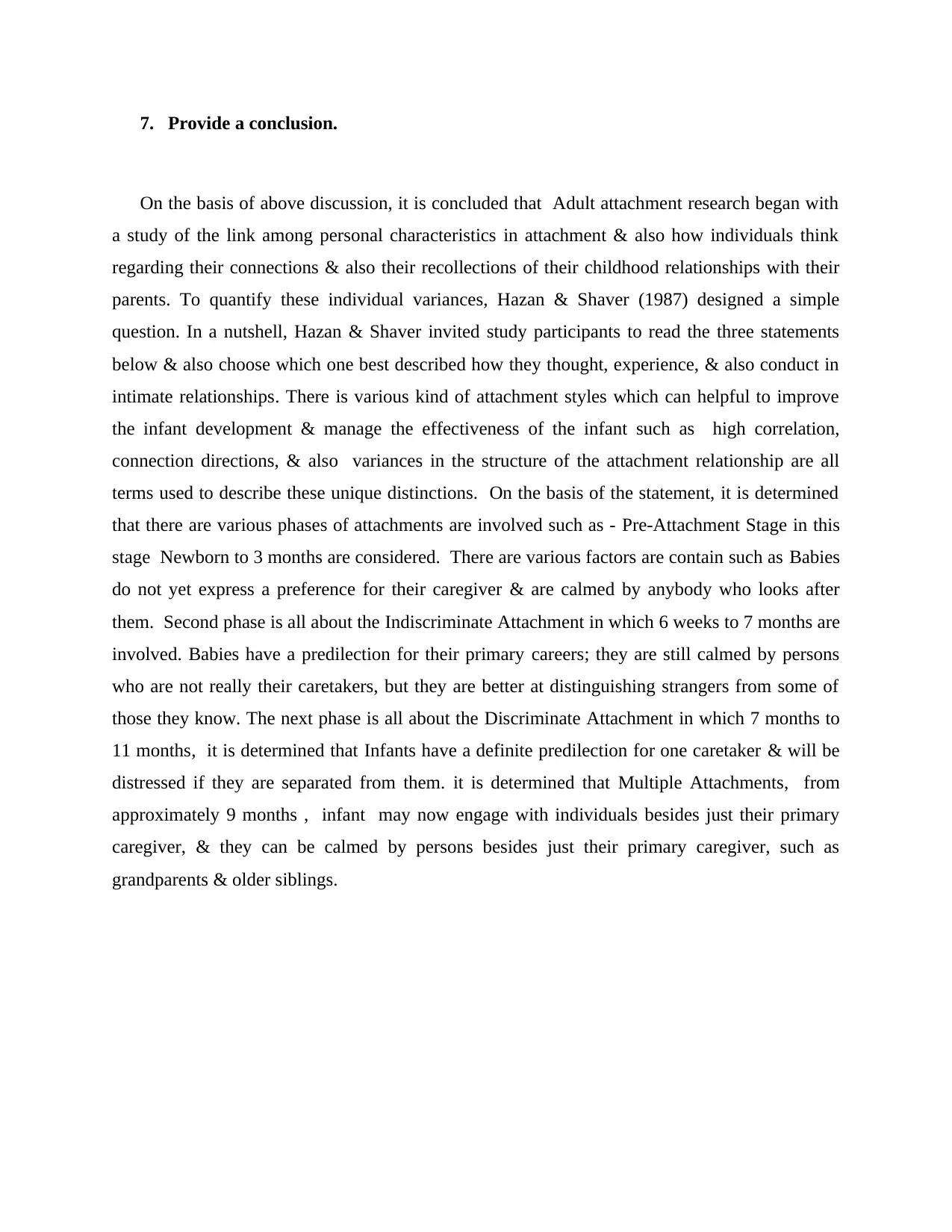
7. Provide a conclusion.
On the basis of above discussion, it is concluded that Adult attachment research began with
a study of the link among personal characteristics in attachment & also how individuals think
regarding their connections & also their recollections of their childhood relationships with their
parents. To quantify these individual variances, Hazan & Shaver (1987) designed a simple
question. In a nutshell, Hazan & Shaver invited study participants to read the three statements
below & also choose which one best described how they thought, experience, & also conduct in
intimate relationships. There is various kind of attachment styles which can helpful to improve
the infant development & manage the effectiveness of the infant such as high correlation,
connection directions, & also variances in the structure of the attachment relationship are all
terms used to describe these unique distinctions. On the basis of the statement, it is determined
that there are various phases of attachments are involved such as - Pre-Attachment Stage in this
stage Newborn to 3 months are considered. There are various factors are contain such as Babies
do not yet express a preference for their caregiver & are calmed by anybody who looks after
them. Second phase is all about the Indiscriminate Attachment in which 6 weeks to 7 months are
involved. Babies have a predilection for their primary careers; they are still calmed by persons
who are not really their caretakers, but they are better at distinguishing strangers from some of
those they know. The next phase is all about the Discriminate Attachment in which 7 months to
11 months, it is determined that Infants have a definite predilection for one caretaker & will be
distressed if they are separated from them. it is determined that Multiple Attachments, from
approximately 9 months , infant may now engage with individuals besides just their primary
caregiver, & they can be calmed by persons besides just their primary caregiver, such as
grandparents & older siblings.
On the basis of above discussion, it is concluded that Adult attachment research began with
a study of the link among personal characteristics in attachment & also how individuals think
regarding their connections & also their recollections of their childhood relationships with their
parents. To quantify these individual variances, Hazan & Shaver (1987) designed a simple
question. In a nutshell, Hazan & Shaver invited study participants to read the three statements
below & also choose which one best described how they thought, experience, & also conduct in
intimate relationships. There is various kind of attachment styles which can helpful to improve
the infant development & manage the effectiveness of the infant such as high correlation,
connection directions, & also variances in the structure of the attachment relationship are all
terms used to describe these unique distinctions. On the basis of the statement, it is determined
that there are various phases of attachments are involved such as - Pre-Attachment Stage in this
stage Newborn to 3 months are considered. There are various factors are contain such as Babies
do not yet express a preference for their caregiver & are calmed by anybody who looks after
them. Second phase is all about the Indiscriminate Attachment in which 6 weeks to 7 months are
involved. Babies have a predilection for their primary careers; they are still calmed by persons
who are not really their caretakers, but they are better at distinguishing strangers from some of
those they know. The next phase is all about the Discriminate Attachment in which 7 months to
11 months, it is determined that Infants have a definite predilection for one caretaker & will be
distressed if they are separated from them. it is determined that Multiple Attachments, from
approximately 9 months , infant may now engage with individuals besides just their primary
caregiver, & they can be calmed by persons besides just their primary caregiver, such as
grandparents & older siblings.

References
Bowlby, R., 2018. Fifty years of attachment theory: the Donald Winnicott memorial lecture.
Routledge.
Dagan, O., Groh, A.M., Madigan, S. and Bernard, K., 2021. A lifespan development theory of
insecure attachment and internalizing symptoms: Integrating meta-analytic evidence
via a testable evolutionary mis/match hypothesis. Brain Sciences, 11(9), p.1226.
Fearon, R.P. and Roisman, G.I., 2017. Attachment theory: progress and future
directions. Current Opinion in Psychology, 15, pp.131-136.
Granqvist, P., 2021. Attachment, culture, and gene-culture co-evolution: expanding the
evolutionary toolbox of attachment theory. Attachment & Human
Development, 23(1), pp.90-113.
Heard, D., Lake, B. and McCluskey, U., 2018. Attachment therapy with adolescents and adults:
Theory and practice post Bowlby. Routledge.
Johnson, S.M., 2019. Attachment Theory. Encyclopedia of Couple and Family Therapy, pp.169-
177.
Levy, K.N. and Johnson, B.N., 2019. Attachment and psychotherapy: Implications from
empirical research. Canadian Psychology/Psychologie Canadienne, 60(3), p.178.
Reisz, S., Duschinsky, R. and Siegel, D.J., 2018. Disorganized attachment and defense:
exploring John Bowlby’s unpublished reflections. Attachment & Human
Development, 20(2), pp.107-134.
Smit, D.J., de Geus, E.J., Boersma, M., Boomsma, D.I. and Stam, C.J., 2016. Life-span
development of brain network integration assessed with phase lag index connectivity
and minimum spanning tree graphs. Brain connectivity, 6(4), pp.312-325.
Van Rosmalen, L., Van Der Horst, F.C. and Van der Veer, R., 2016. From secure dependency to
attachment: Mary Ainsworth’s integration of Blatz’s security theory into Bowlby’s
attachment theory. History of Psychology, 19(1), p.22.
Bowlby, R., 2018. Fifty years of attachment theory: the Donald Winnicott memorial lecture.
Routledge.
Dagan, O., Groh, A.M., Madigan, S. and Bernard, K., 2021. A lifespan development theory of
insecure attachment and internalizing symptoms: Integrating meta-analytic evidence
via a testable evolutionary mis/match hypothesis. Brain Sciences, 11(9), p.1226.
Fearon, R.P. and Roisman, G.I., 2017. Attachment theory: progress and future
directions. Current Opinion in Psychology, 15, pp.131-136.
Granqvist, P., 2021. Attachment, culture, and gene-culture co-evolution: expanding the
evolutionary toolbox of attachment theory. Attachment & Human
Development, 23(1), pp.90-113.
Heard, D., Lake, B. and McCluskey, U., 2018. Attachment therapy with adolescents and adults:
Theory and practice post Bowlby. Routledge.
Johnson, S.M., 2019. Attachment Theory. Encyclopedia of Couple and Family Therapy, pp.169-
177.
Levy, K.N. and Johnson, B.N., 2019. Attachment and psychotherapy: Implications from
empirical research. Canadian Psychology/Psychologie Canadienne, 60(3), p.178.
Reisz, S., Duschinsky, R. and Siegel, D.J., 2018. Disorganized attachment and defense:
exploring John Bowlby’s unpublished reflections. Attachment & Human
Development, 20(2), pp.107-134.
Smit, D.J., de Geus, E.J., Boersma, M., Boomsma, D.I. and Stam, C.J., 2016. Life-span
development of brain network integration assessed with phase lag index connectivity
and minimum spanning tree graphs. Brain connectivity, 6(4), pp.312-325.
Van Rosmalen, L., Van Der Horst, F.C. and Van der Veer, R., 2016. From secure dependency to
attachment: Mary Ainsworth’s integration of Blatz’s security theory into Bowlby’s
attachment theory. History of Psychology, 19(1), p.22.
⊘ This is a preview!⊘
Do you want full access?
Subscribe today to unlock all pages.

Trusted by 1+ million students worldwide
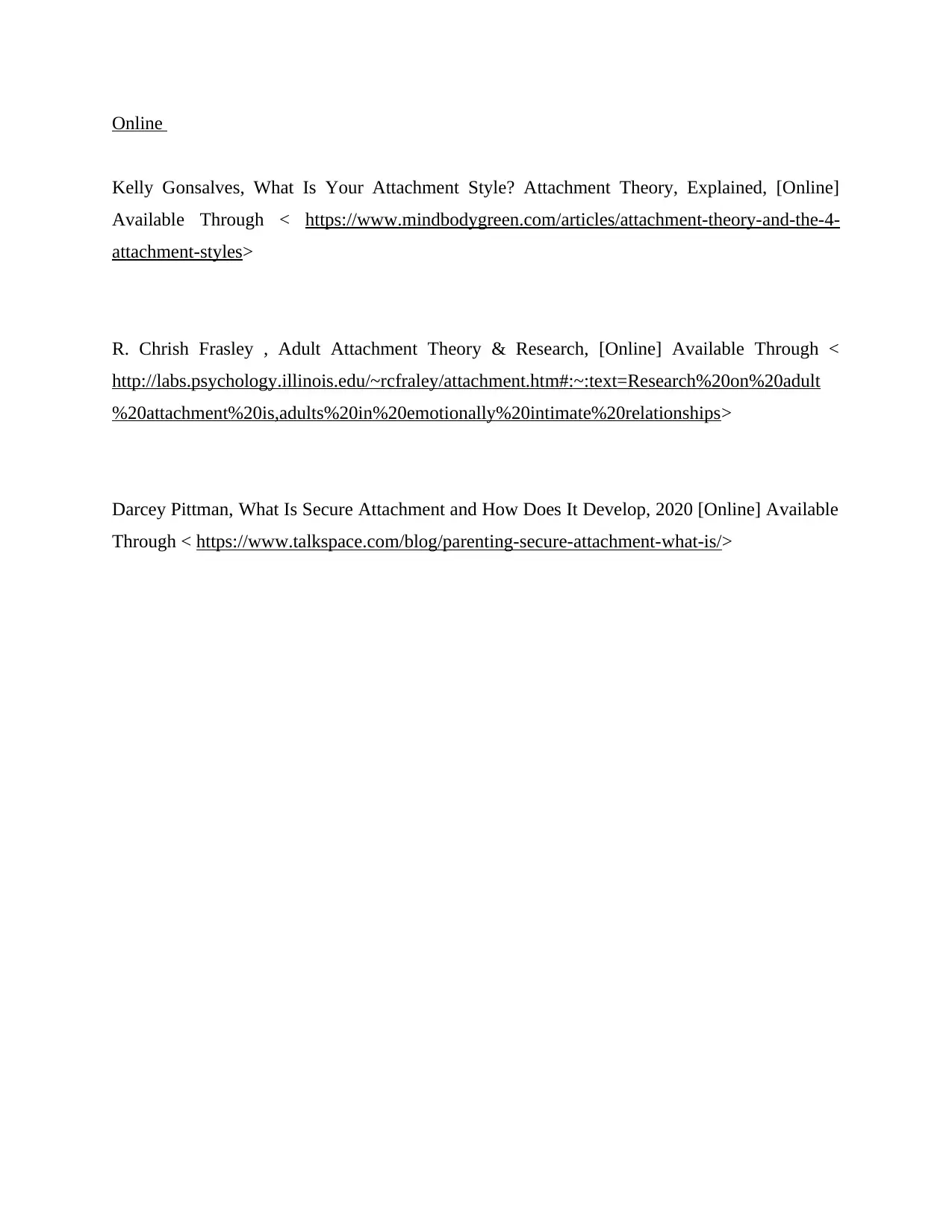
Online
Kelly Gonsalves, What Is Your Attachment Style? Attachment Theory, Explained, [Online]
Available Through < https://www.mindbodygreen.com/articles/attachment-theory-and-the-4-
attachment-styles>
R. Chrish Frasley , Adult Attachment Theory & Research, [Online] Available Through <
http://labs.psychology.illinois.edu/~rcfraley/attachment.htm#:~:text=Research%20on%20adult
%20attachment%20is,adults%20in%20emotionally%20intimate%20relationships>
Darcey Pittman, What Is Secure Attachment and How Does It Develop, 2020 [Online] Available
Through < https://www.talkspace.com/blog/parenting-secure-attachment-what-is/>
Kelly Gonsalves, What Is Your Attachment Style? Attachment Theory, Explained, [Online]
Available Through < https://www.mindbodygreen.com/articles/attachment-theory-and-the-4-
attachment-styles>
R. Chrish Frasley , Adult Attachment Theory & Research, [Online] Available Through <
http://labs.psychology.illinois.edu/~rcfraley/attachment.htm#:~:text=Research%20on%20adult
%20attachment%20is,adults%20in%20emotionally%20intimate%20relationships>
Darcey Pittman, What Is Secure Attachment and How Does It Develop, 2020 [Online] Available
Through < https://www.talkspace.com/blog/parenting-secure-attachment-what-is/>
1 out of 10
Related Documents
Your All-in-One AI-Powered Toolkit for Academic Success.
+13062052269
info@desklib.com
Available 24*7 on WhatsApp / Email
![[object Object]](/_next/static/media/star-bottom.7253800d.svg)
Unlock your academic potential
Copyright © 2020–2025 A2Z Services. All Rights Reserved. Developed and managed by ZUCOL.




